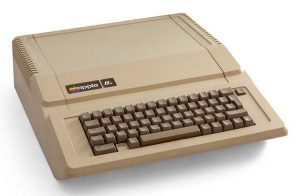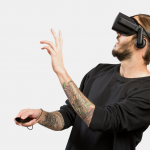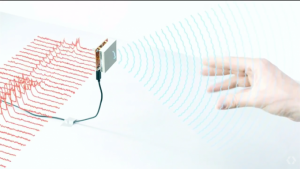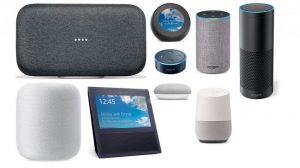For years radios had been operated by means of pressing buttons and turning dials; then as the technology became more sophisticated the controls were made touch-sensitive–you merely had to brush the panels with your fingers; now all you had to do was wave your hand in the general direction of the components and hope. It saved a lot of muscular expenditure, of course, but meant that you had to sit infuriatingly still if you wanted to keep listening to the same program.
Hitchhiker’s Guide
 There has been many attempts at providing newer and better ways to interface with computers ever since the first keyboard was invented. Many of these have resulted in feelings not too dissimilar to Douglas Adams observation about their practicality. We are entering a era though of some exciting changes coming to the way we are able to interface with computers and while they are unlikely to every entirely replace the more traditional keyboard and mouse they definitely bring something useful to the table.
There has been many attempts at providing newer and better ways to interface with computers ever since the first keyboard was invented. Many of these have resulted in feelings not too dissimilar to Douglas Adams observation about their practicality. We are entering a era though of some exciting changes coming to the way we are able to interface with computers and while they are unlikely to every entirely replace the more traditional keyboard and mouse they definitely bring something useful to the table.
For many years it has been the dream of sci-fi to allow us to use  our whole bodies to be able to interact with the digital word and we are starting to be able to do that now in our own homes. Two competing products have just started entering homes the HTH VIVE and the Oculus Rift. Both of these products consist of a virtual reality(VR) headset and motion controllers that you hold. While VR is still in its infancy in the home market it is definitely showing promise as a whole different way to interact with a computer. From simulated archery to virtually visiting and learning about the pyramids of egypt VR might someday be as inseparable as our smartphones are now to us.
our whole bodies to be able to interact with the digital word and we are starting to be able to do that now in our own homes. Two competing products have just started entering homes the HTH VIVE and the Oculus Rift. Both of these products consist of a virtual reality(VR) headset and motion controllers that you hold. While VR is still in its infancy in the home market it is definitely showing promise as a whole different way to interact with a computer. From simulated archery to virtually visiting and learning about the pyramids of egypt VR might someday be as inseparable as our smartphones are now to us.
 Incase you think that the touch screen is the only way to interact with your smartphone then think again. Project Soli by Google has, I think, some of the most promise as a rising new computer interface. With project Soli a miniaturized radar chip is able to be embedded into a computer or smartphone and used to detect movement nearby the device. In demonstrations it has been shown to detect different sorts of gestures made with the user’s fingers in the air nearby the device. The is shown to be used to change the volume of music by making a turn-the-dial up or down motion in the air and the device recognizing this. Being able to “press” a button by just tapping your index finger together with your thumb and other interesting gesture controls are possible.
Incase you think that the touch screen is the only way to interact with your smartphone then think again. Project Soli by Google has, I think, some of the most promise as a rising new computer interface. With project Soli a miniaturized radar chip is able to be embedded into a computer or smartphone and used to detect movement nearby the device. In demonstrations it has been shown to detect different sorts of gestures made with the user’s fingers in the air nearby the device. The is shown to be used to change the volume of music by making a turn-the-dial up or down motion in the air and the device recognizing this. Being able to “press” a button by just tapping your index finger together with your thumb and other interesting gesture controls are possible.
From sight and motion and onto the last major area that is being pursued as the next means of interface, sound. If there is one type of interface that has shown up most consistently in sci-fi and futurism it would be the voice interface to a computer. From Star Trek to Alexa this has been a major promise of computers. To be able to just tell them what we wanted them to do instead of having to stop and enter key presses to make things work. For many years voice recognition has been clunky at best, finding niches in some areas of work such as transcription but failing to live up to its initial promise of general purpose control. This is beginning to change with modern techniques to help the computer better understand sounds and context of the user. With the release of Google’s Duplex demo a whole new world of better voice control and interaction is set to take place. With Duplex Google has demonstrated the ability for a digital assistant to be able to call a business, place a request for an appointment and to be able to respond to a human in a way that makes sense. While I am sure that the time for this level of sophistication is still some ways away from the general public it does point to a time when we would all be able to turn to our computer and order “Tea, Earl Grey, Hot”. 
So where do these new technologies leave the humble keyboard and mouse? Still firmly relevant. While I feel that motion, movement tracking, and audio present great new ways to enter data into a computer I am unable to see a path the would consist of computers not having the more traditional means of data entry. What I feel these new technologies will bring is to even better integrate computers into our everyday lives in ways that we are just starting to image. From Alexa controlled sound systems in our house to Nest thermostats controlling our AC we are entering a time of pervasive computing that will require new novel ways to let us enter data and I for one am excited to see where it takes us.
References:
“HTC VIVE vs Oculus Rift” https://www.techradar.com/news/wearables/htc-vive-vs-oculus-rift-1301375 “Project Soli” https://www.youtube.com/watch?v=0QNiZfSsPc0 “Duplex” https://metro.co.uk/2018/05/09/google -unveils-cyber-secretary-uses-artificial -intelligence-make-phone-calls-7532194/

